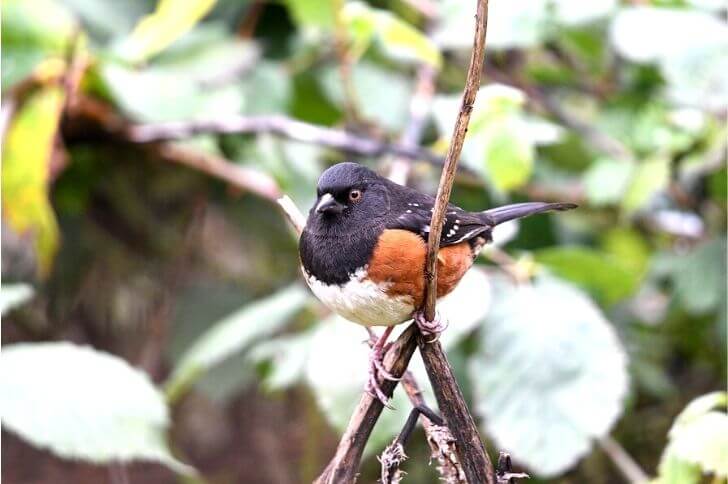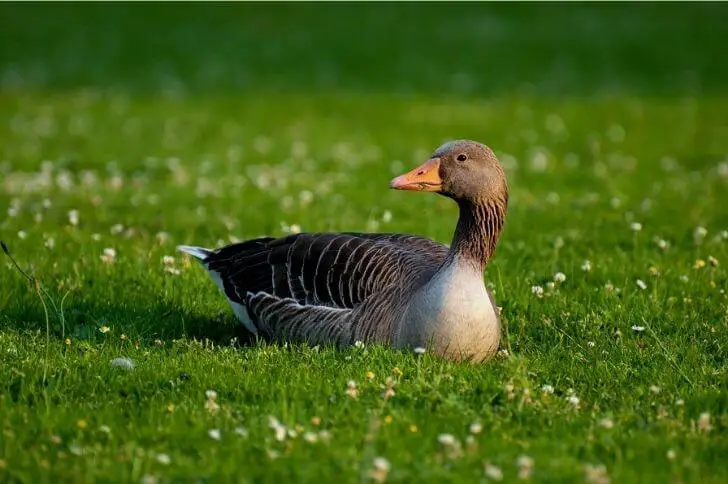Birds are a vital part of the ecosystem in Yellowstone National Park. There are over 300 species of birds that have been documented in the park.
These birds play an important role in controlling the populations of insects and other animals. They also help to spread seeds and pollinate plants. The bird population in Yellowstone is managed by the US Fish and Wildlife Service.
Below we explore the most common birds of Yellowstone. We’ll discuss their juvenile and adult plumage, breeding habitat and more.
List of Birds of Yellowstone National Park
1. Bald Eagle

Bald eagles are a species of eagle found all over North America. They are also found in large numbers in Yellowstone National Park and are one of the most important raptors in this region. Do you know how to identify this bird?
Identification:
Adult birds of this family are dark brown overall with a brilliant white head and tail. They have a wingspan of up to 2.3 feet to 3.15 feet and can weigh up to 14lbs. Bald eagles are not actually bald, but they do have less feathers on their head than other types of eagle.
Interesting facts:
Bald eagles are carnivores and eat mostly fish. They hunt by swooping down on their prey from the air. Bald eagles usually nest in trees near water, where there is plenty of food for them to eat.
Bald eagles were once endangered, but they have made a comeback in recent years thanks to conservation efforts.
2. Peregrine Falcons

Peregrine falcons are among the most fascinating and majestic birds in Yellowstone National Park. These raptors have been known to reach speeds of over 200 miles per hour when diving for prey.
Identification:
They are one of the largest falcons in Yellowstone national park. The adult has a dark gray back, a white throat and a heavily barred belly. Note the brilliant yellow bill and eyerings. Also, this large bird spots yellow feet and sharp talons.
Other facts:
When do peregrine falcons breed? Their nesting season starts from March through May. A mature female lays 2-5 eggs that are incubated for up to 32 days. These large birds are important to this ecosystem because they help control populations of sandhill cranes, rodents and fish in this region.
Whether you’re lucky enough to see one in the wild or simply admire them from afar, peregrine falcons are truly impressive animals.
3. Gray Jay

Gray jays are medium-sized members of the crow family. Also known as the camp robber or Canada Jay or Whisky Jack, these birds are not as impressive as other birds on this list.
Identification:
Be on the look for a dull-looking bird; It has a medium size body, around 9.8 to 13 inches long. Their backs are a dark gray, pale below and a round head with a white forehead. Note its sharp wings and pointed tail. Its bills are short and black.
Other facts:
The Canada jay is a nonmigratory bird, spending its entire life in the same general area. The Canada jay is an opportunistic feeder, eating a wide variety of foods including insects, berries, nuts, and small mammals. It will also cached food for later use. The bird has been known to follow hikers and campers in hopes of being offered a handout.
The gray jay is a social bird, living in pairs or small family groups. It builds its nest in tree cavities or on ledges, using mosses, lichens, and other soft materials.
4. Sandhill Cranes

Sandhill cranes are one of the most interesting and unique bird species in Yellowstone National Park. How long do they live? Oldest recorded birds lived for 35 years but they average 15-20 years.
Identification:
These birds are known for their long necks, legs, and bills, as well as their striking red crowns. Their bodies are overall gray with some tan feathers. Note their stunning yellow eyes. On average, the adult sandhill cranes are about 47 inches and length and 78.7 inches in length.
Other facts:
Sandhill cranes are also known for their loud and booming calls, which can be heard up to two miles away. These birds mate for life and typically live in wetland habitats. So you can find them around the Yellowstone lake and river.
Sandhill cranes are an important part of the Yellowstone ecosystem. These birds help to regulate insect, snail, and nesting bird populations and disperse seeds throughout their habitats.
5. Trumpeter Swans
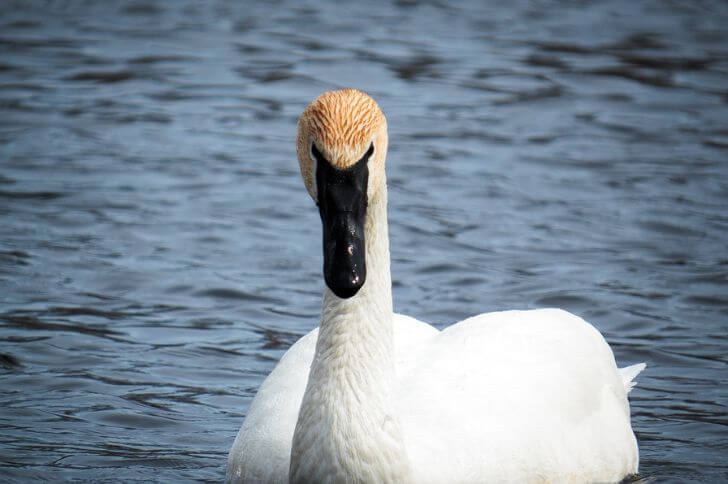
Trumpeter swans are one of the largest waterfowl in Yellowstone National Park. They are also the heaviest flying bird in this park.
Identification:
The Trumpeter Swan is a very large bird, with a length of up to five feet and a wingspan of over 6.5 feet. The average weight of an adult Trumpeter Swan is about twenty-five pounds, but some individuals can weigh as much as forty pounds. The Trumpeter Swan is mostly white, with black legs and bill.
6. Dusky Grouse

Formerly known as the blue grouse, the dusky grouse is a chicken-like bird that prefers solitary life. You’ll notice the bird foraging alone and if in a group, it’s a mother and its babies.
Identification:
They are a type of grouse, and are closely related to the ruffed grouse. The blue grouse is the second largest member of its family. They have a brownish-gray plumage with white markings on their wings. Adult males also have a black tail with gray tips. Females and juveniles have a brownish plumage.
Other facts:
Dusky grouse live in forests and mountainous areas. They eat insects, berries, and other small invertebrates. In the winter, they eat fir needles and twigs. During breeding season they raise one brood with up to 12 grouse babies.
7. Prairie Falcons

Prairie falcons are not as large as the peregrine falcons above but they are still an important park wildlife. These Yellowstone bird species are easy to identify.
Identification
Prairie falcons are medium-sized raptors with long, pointed wings and a long tail. They are brown above and white below, with a streaked pattern on their breast and belly. Adults are about 18 inches in length. Note their dull yellow feet and sharp talons.
Other facts:
Prairie falcons eat mostly small mammals and birds. They can be found in open habitats from grasslands to prairies to mountain areas.
Prairie falcons are important predators in the park’s ecosystem. They help to keep populations of small mammals and birds in check, which can help to prevent disease outbreaks and maintain healthy plant communities.
Related Read: See San Diego birds
8. Golden Eagles

Majestic and beautiful, Golden eagles are the largest and most powerful birds of prey in Yellowstone National Park.
Identification:
With a wingspan of up to 7 feet, they are formidable predators that can take down animals as large as deer and coyotes. Overall their bodies are dark brown. Also immature birds are dull brown with white patches.
Other facts:
Although they are still hunted by humans in some parts of the world, golden eagles are protected in most countries. In Yellowstone, it is illegal to kill them. These majestic birds have been revered by cultures throughout history and continue to inspire awe in those who encounter them today.
9. Great Horned Owl

We’ve looked at the largest birds of prey in the Yellowstone National Park ecosystem, now let’s discuss the heaviest bird; the great horned owl.
Identification:
The great horned owl is a striking bird of prey. They typically are 18-24.8 inches in length and boast a span of up to 57.1 inches.
They are born with white down feathers and when they molt you’ll notice their gorgeous gray and brown plumage. Note their brilliant yellow eyes.
Other facts:
Its large size and powerful talons make it a fearsome predator. The great horned owl has a distinctive call that sounds like a hoot, and it is often seen perched atop trees, waiting to swoop down on its unsuspecting prey.
These owls are nocturnal hunters, and they use their sharp eyesight and hearing to locate their prey. The great horned owl is an impressive bird, and it is sure to leave you awestruck the next time you see one.
10. American Robins

Found all over North America, the American robin is a resident breeder in this National Park. They are easily recognizable by their distinctive plumage.
Identification:
They are generally dark gray on their back, black head and a rusty orange belly. They spot a yellow bill and white eyering. Note their round belly and pointed wings. Immature robins have duller coloring.
Other facts:
American robins eat insects, berries, and fruits. They build their nests in trees. In the winter, these birds migrate to southern parts of the United States.
11. American dipper
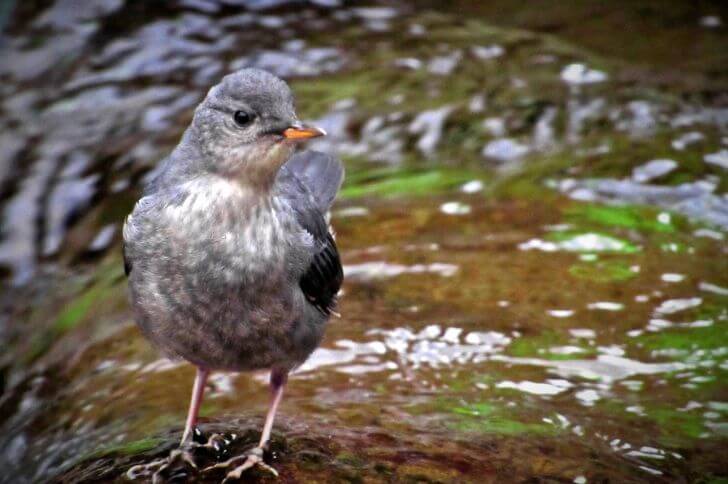
Found on the banks of the Yellowstone river, the American dipper is a small bird that is also called the water ouzel.
Identification:
The dipper is a small, dark-colored bird that is most commonly found near running water. It’s typically dark gray with a short tail and a round body. Its bill is dark but immature birds have a yellowish bill. The bird’s legs are strong and it has sharp claws that help it grip onto rocks.
Other facts:
The bird gets its name from its habit of dipping its head into the water to catch insects. The dipper is known for its ability to swim and walk under water.
This bird eats mostly insects, but can also be seen eating small fish, amphibians, and berries.
12. American white pelican
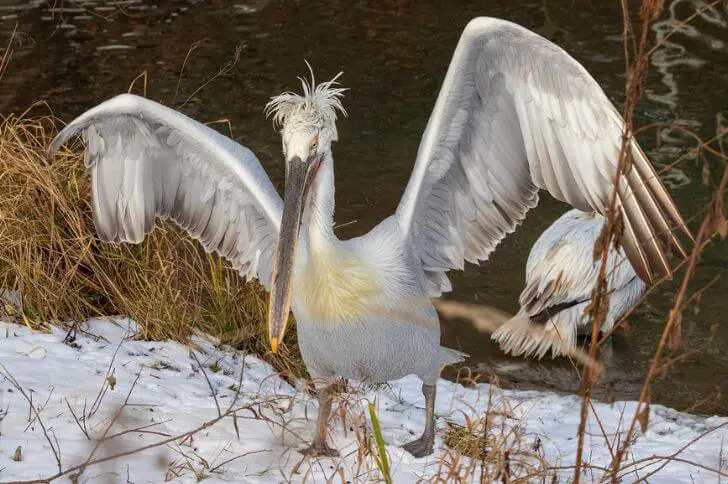
Found around the floating island lake around Yellowstone, these large birds prefer nesting in this region. Here is how to identify them.
Identification:
The American white pelican is a large bird with a wingspan of up to 9 feet. They are mostly white with black underwings for breeding adults. Also, they have a long yellow bill. Note the pouch used to scoop fish.
Other facts:
These birds are often seen flying in formation or swimming in large groups. In Yellowstone national park, they nest in Molly Islands and breed in colonies.
Their nests are usually made of sticks and twigs, and they lay 2-3 eggs per clutch. Pelicans typically eat fish, but they will also eat crustaceans, insects, and other small animals.
Also, these birds of Yellowstone National Park are excellent swimmers and can often be seen swimming with their heads submerged, using their bills to scoop up fish. They are also very good flyers, and can fly at speeds of up to 35 miles per hour!
13. Mountain Chickadee

One of the most common birds in Yellowstone is the Mountain Chickadee. It’s also one of the smallest birds in this ecosystem.
Identification:
The adult bird is about 5 inches long. They are grayish overall with a black head and throat. Note the white cheeks.
Other facts:
Their distinctive calls sound like “chick-a-dee-dee-dee” and “fee-bee”. Unlike other chickadees, they prefer coniferous forests but will nest on aspen trees which are softer.
Mountain chickadees are social creatures, often seen in pairs or small flocks. They are acrobatic flyers, capable of hovering and even flying backwards. Their diet consists mainly of insects, but they will also eat seeds and berries.
14. Common Raven
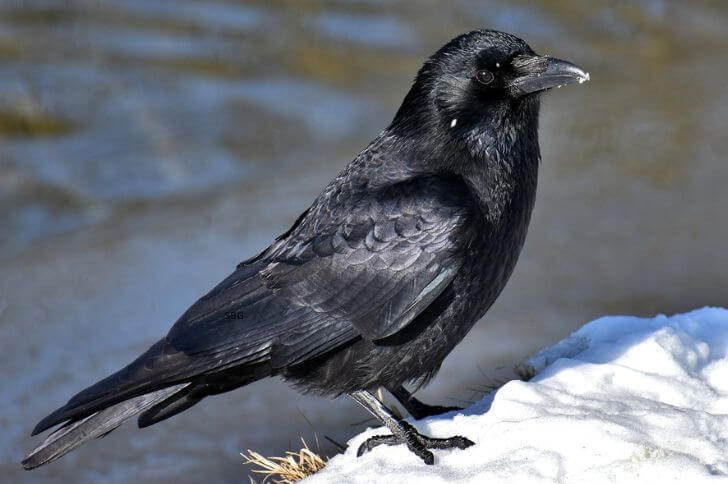
Smart and curious, common ravens are carrion feeders that help clean up the Yellowstone national park.
Identification:
Ravens are large, all black birds with a distinctive croaking call. They are intelligent and adaptable, and are known for their mischievous nature.
Other facts:
Ravens are found in forests and mountains. They are omnivorous birds, and will eat just about anything they can find. Their diet consists of insects, small mammals, carrion, and garbage. In Yellowstone, you can spot them following wolves to eat what remains.
Common ravens are highly social birds, often traveling in flocks of up to 100 individuals. They mate for life and build large nests made of sticks high up in trees. Learn more about these blackbirds nesting habits.
16. Common Loon

Common loons are considered an endangered bird species in Wyoming. This is due to Habitat loss. A majority of breeding adults in this State are found in Yellowstone. Here are its size and plumage.
Identification:
Common loons are typically black and white with red eyes. Bill is thick and sharp and the head is all black.
Interesting facts:
Loons are excellent swimmers and can often be seen swimming alone or in pairs. They are also very good at diving, and can stay underwater for up to a minute at a time.
Loons typically eat fish, but they will also eat amphibians, reptiles, and insects. They usually hunt by diving into the water and catching their prey with their bills. Loons nests are built on the ground near water, and both parents help to incubate the eggs and care for the young chicks.
Loons are interesting birds that have many unique behaviors and adaptations. If you ever have the chance to see one, be sure to take the time to watch it!
17. Red-tailed Hawks
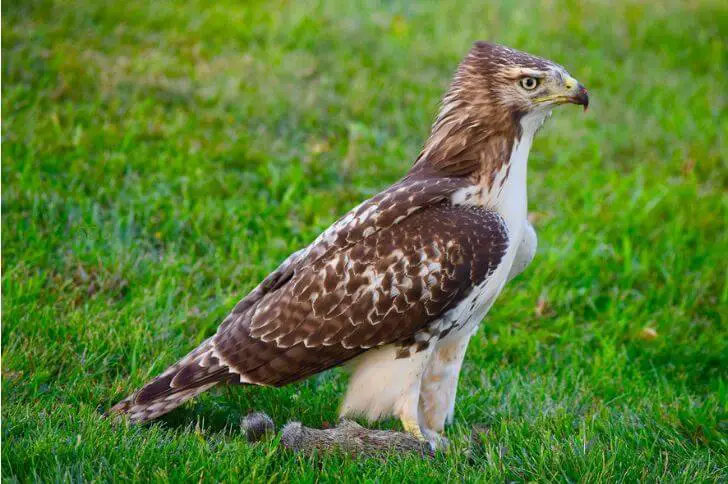
Are there hawks in Yellowstone? Red-tailed hawks are a common sight in this park. These large, powerful birds of prey are easily recognizable by their characteristic red tail feathers.
Identification:
They are heavier compared to most birds in their family. The average bird has a body mass of 45 oz. Adults are brown and pale below, with a band around their belly. Note their wide, reddish tail.
Other facts:
They are often seen soaring above open fields or perched atop trees. These adaptable birds hunt small mammals, reptiles, and birds. They typically perch in a high spot and watch for movement below, then swoop down to capture their prey with their talons. Red-tailed hawks mate for life and generally lay two or three eggs per year.
These magnificent Yellowstone birds still grace our skies and provide us with a glimpse of wildness in our otherwise busy lives.
18. Northern Saw-Whet Owl

Northern saw-whet owls are one of the smallest birds of Yellowstone park. It gets its name from its call, which sounds like a saw being sharpened on a whetstone.
Identification:
Adult birds are 7-8.3 inches in length, the same size as a Canada Jay. They have white and brown feathers and a round head. Unlike other birds, they do not have tufted ears. Juvenile owls are a dull brown.
Other facts:
These owls are nocturnal. They hunt for their food, mostly small mammals such as mice and voles, using their sharp talons and beak.
Northern saw-whet owls are migratory birds, meaning they travel to different areas at different times of the year. In the winter, they can be found in southern Canada and the northern United States.
FAQs
What are common birds in Yellowstone?
The most common birds of Yellowstone national park include Sandhill cranes, Bald eagles, dusky grouse, mountain chickadee, American dipper and trumpeter swans.
What are big black birds at Yellowstone?
Large black birds of Yellowstone include common ravens, turkey vultures and golden eagles.
Are there golden eagles in Yellowstone?
Yes, in this national park there are a number of golden eagles and 20 known nesting sites.
What kind of eagles are in Yellowstone national park?
In Yellowstone, you can find the bald eagle and golden eagle.
Are there falcons in Yellowstone?
Two types of falcons are residents of the Yellowstone national park; the peregrine falcon and prairie falcons.
Are there Ospreys in Yellowstone?
Ospreys are part of the Yellowstone ecosystem. As recently as 2019, their nesting sites were monitored and 70% of the incubated eggs hatched successfully.
Sources:
https://en.wikipedia.org/wiki/Peregrine_falcon
https://www.yellowstonewildlifesanctuary.org/sandhill-crane
https://www.audubon.org/field-guide/bird/great-horned-owl
Hi fellow bird watcher. Welcome to our small corner of the world. At the spanishbirdguides.com our mission is to share with other bird watchers the things we love about birds, where to go bird watching within the United States, and more. I’d also love to hear from you. Feel free to contact me about your bird watching escapades, share videos, photos and more.
